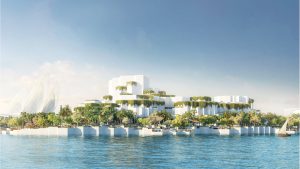ABU DHABI / AD MEDIA OFFICE
The Department of Culture and Tourism – Abu Dhabi (DCT Abu Dhabi) and Miral have revealed 65 percent completion of the overall development of the Natural History Museum Abu Dhabi. Located within Saadiyat Cultural District, the museum is set to be the largest of its kind in the region, once construction is completed by the end of 2025.
Upon completion, the museum will take visitors on a 13.8-billion-year journey through time and space — from the earliest origins of our universe, exploring the abundance of life on Earth today, and looking into the future. Structural works of the 35,000 sqm museum is largely complete with a current focus on the installation of mechanical, electrical, and plumbing (MEP), building fit-out, and exhibition works.
The museum was topped out by His Excellency Mohamed Khalifa Al Mubarak, Chairman of DCT Abu Dhabi and Miral, His Excellency Saood Abdulaziz Al Hosani, Undersecretary of DCT Abu Dhabi and Mohamed Abdallah Al Zaabi, Group CEO of Miral, which was followed by a visit of the development to check construction progress.
His Excellency Saood Abdulaziz Al Hosani, Undersecretary of the Department of Culture and Tourism – Abu Dhabi, said: “The Natural History Museum Abu Dhabi will play a key role in advancing science and inspiring environmental stewardship in our children while furthering Abu Dhabi as a global centre for research and collaboration. By cultivating a generation passionate about the natural sciences, we seek to enrich lives through education and scientific discovery, in turn encouraging people to actively care for the planet’s future. Set to inspire visitors of all ages by unlocking billions of years of knowledge about our planet, this progress update is an indication of concrete steps towards curating a thought-provoking perspective of the future and igniting a passion for the natural world.”
Mohamed Abdalla Al Zaabi, Group CEO of Miral, said: “The progress we are witnessing in the development of the Natural History Museum Abu Dhabi marks an important milestone in our journey to contribute to the evolution of the emirate’s cultural landscape. Working in close partnership with DCT Abu Dhabi, we have a shared vision for the development of this iconic landmark. Once complete, the museum will play an integral role in enhancing access and engagement with the natural sciences while supporting the emirate’s tourism ecosystem and economic diversification.”
The Natural History Museum Abu Dhabi will present the history of the universe and the story of life on Earth, as well as provide a glimpse into a more sustainable future. In addition to global natural history, this narrative will be framed through an Arabian lens for the first time, with the fauna, flora, and geological history of the region, a prominent part of the visitors’ journey.
Exceptional specimens and significant artefacts unlock some of the most important stories of our natural world. These specimens and stories will be enhanced by immersive displays, built on a foundation of research and scientific analysis.
The museum is carefully curated by a dedicated team of specialists, world-leading scholars and natural science experts.
The Natural History Museum Abu Dhabi will also serve as a research and educational institution, supporting scientific knowledge and creating a think tank for future innovation and emerging technologies. A dedicated research facility will undertake innovative scientific studies in zoology, palaeontology, marine biology, molecular research and earth sciences.
The museum will join the diverse cultural institutions and museums that comprise Saadiyat Cultural District, which features Louvre Abu Dhabi; Manarat Al Saadiyat cultural centre; and Berklee Abu Dhabi. The district will soon welcome Zayed National Museum, the national museum of the United Arab Emirates, Guggenheim Abu Dhabi, focusing on Modern and Contemporary art; and teamLab Phenomena Abu Dhabi, where art and architecture blend with cutting-edge technology and science.
 The Gulf Time Newspaper One of the finest business newspapers in the UAE brought to you by our professional writers and editors.
The Gulf Time Newspaper One of the finest business newspapers in the UAE brought to you by our professional writers and editors.
